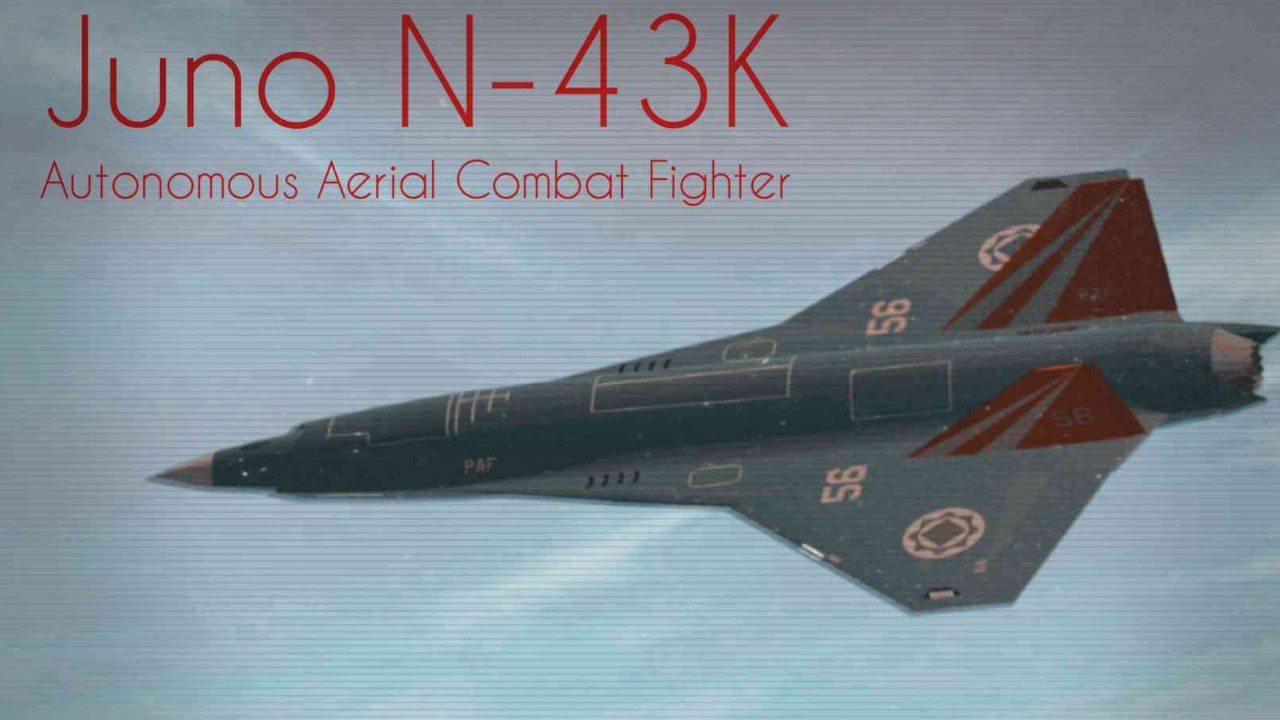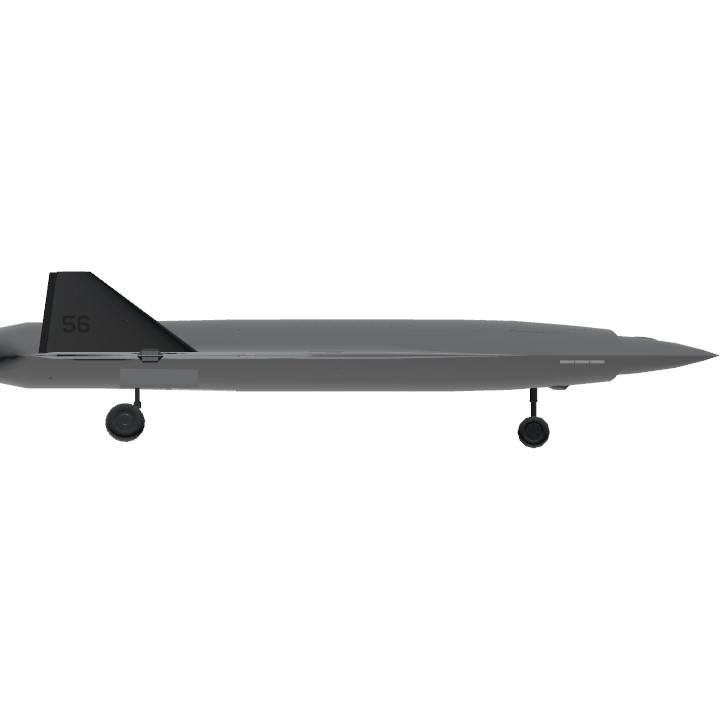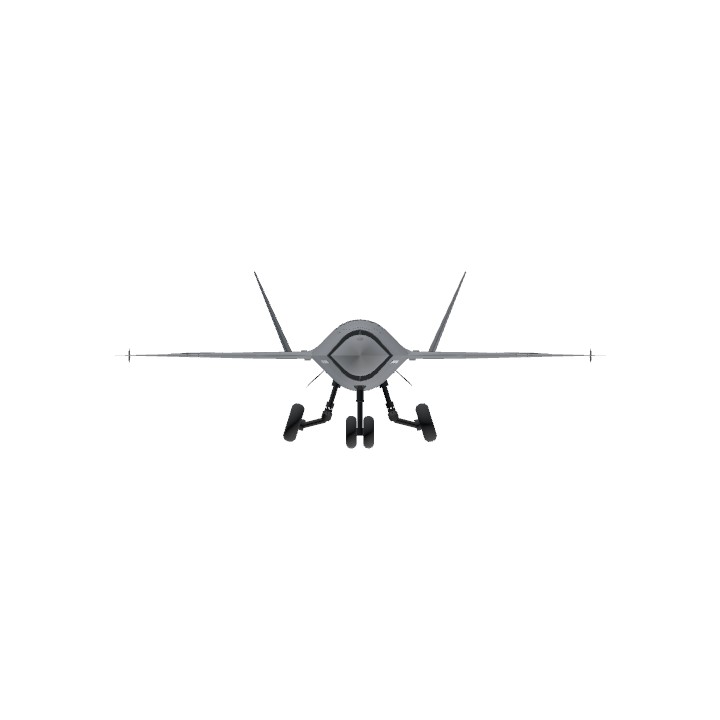
Juno N-43K "Neuro"
Juno Arms Industry, NEURON Complement Mark 43, Variant K
G1 Radar Absorbing Paint
Origin: Pan-Obelia Confederation
Manufacturer: Kola Arm Industry, Luminarium Aeronautics, Juno Arm Industry, AWRD Section B
Operator(s): Pan-Obelia Air Force (PAF)
Main Role: Autonomous Aerial Combat Fighter
Piloting System: Gemini-N Hivemind AI System
Designed: 2045-2068
In-service: 2069
Length: 13.7m
Wingspan: 8.9m
Height: 3.2m
Powerplant: 1x Cheirosiphon-C2 Afterburning Turbofan
Max Speed: 2.450kph on high altitude
Cruise Speed: 1.100kph
Range: 3.000km – 4000km
Armaments:
1 x 20mm Rotating Autocannon
4x RK/M-4A Short Range Air-to-Air Missile
3x RK/L-8T Advanced Medium Range Missile
Avionics:
Absolutio-C2N Electronically Scanning Array (AESA) Radar
2A1 Solus-B Infrared Search and Track (IRST)
Luminarii MORTIS (Modular Offensive-Reactive Tactical Interception System) Electronic Warfare System
Gehenna NEURON (Neural Responsive Offensive Network) Hivemind Network System
Gen 7 Omnidirectional Awareness Sensor
DESCRIPTION

After the success of Gemini-S and X-23A prototype, Obelia aimed to mass produce an autonomous fighter using the overall database of Gemini-S as mainframe for the new, mass produced unit named Gemini-N which interconnected with each other via hivemind system called NEURON (Neural Responsive Offensive Network).
Came the N-43K, a much smaller and cheaper variant of X-23A. It has less sophisticated sensor than its predecessor, but it is much cheaper to produce and maintain in a large number. Single-engine, stealth capable, compact fighter that could respond any air threat present with high and precise lethality.
It capable of carrying up to 7 missiles internally, usually consisted of; 4x RK/M-4A Short Range Air-to-Air Missile and 3x RK/L-8T Advanced Medium Range Missile. Both weapon is an improved variant of the one carried by X-23A, further enhancing its lethality.
DEVELOPMENT HISTORY

Started out as Project Unborn, it was issued just after the Austerland-Obelian War in 2043, still within Initiative Vega, and accepted into development in 2045 under total secrecy. This project aim to develop of mass produced fighter jet piloted Gemini AI system, using the basis of Gemini-S that has proven successful. In short, an army of faceless aces.
The project initiated in 2045 under the Research & Development Wing of the Imperial Strategic Bureau (formerly Northern Obelia Strategic Bureau), and unlike Gemini-S' long and financially limited development, Project Unborn receives a pretty large fund from the government. The outline of the AI system quickly drawn from Gemini-S system, named "Gemini-N" and it is a direct descendant of Gemini-S but without the quirk and personality; a total, faceless killing machine programmed for combat. Unlike the Gemini-S' growth that leans to more human-sided, Gemini-S growth focuses on efficiency in combat and aerial warfare, making it highly lethal in combat.
The initial idea was to make each system individual, but later scrapped and come the Project Gehenna. Project Gehenna aims to create a hivemind network between each Project Unborn fighters and AI System, thus changed it into a highly organized swarm of lethal AI aces. Project Gehenna' neural network; NEURON (Neural Responsive Offensive Network) will serve as secure flow of data transfer, allowing each fighters linked into one singular mind. If one spot a target, everyone can track it, this allows a better teamwork. However, the problem is that Gemini-S' flight record mostly contain an individual combat with very little teamwork from its wingmen. So, Gemini-N require a new sheet of paper and rigorous test for hivemind combat style. This very problem delayed the development until the Winter of 2046, it is decided to redo many of the test using Gemini-S and its newly developed twin; Libra-S. Both aimed to record a database for teamwork in air combat.
Many of their record based and simulated combat, and the only war it ever fought on was between Glotisch-Waldreich Conflict (2050-2052), where Imperium Obelia served as supporting power for Waldreich to gain a political leverage in Sudland subcontinent. Despite Waldreich losing the war, the twin faceless pilot; Gemini-S and Libra-S shot down 102 fighters in total. In this war too, the twin faces their first faceless opposite -- Austerland' own AI fighters; The "Geist". It was more aggressive and lethal, but thanks to Gemini-S' adaptive and quick learning capability and Libra-S teamwork leaned combat style, they manage to win against the rival ace after nearly being shot down in more than 5 encounters and engagements. All encounters kept in secret between both rivalling power.
The project later delayed for few years after the re-separation of South Obelia and North Obelia due to violent internal conflicts. The Neo Imperium disbanded, replaced by more democratic Pan-Obelia Confederation that included few more smaller Illian Tongue speaker countries in 2054. The Initiatives and Projects initially kept secret by Imperial Strategic Bureau transferred to the newly established Pan-Obelia Strategic Service, with few leaked to public but quickly handled. The Project Gehenna and Unborn later continued in 2055. Project Unborn later passed the field test phase and onto mass production in 2060, while NEURON being integrated within the Pan-Obelia's AEGIS Defense Network.
DEPLOYMENT HISTORY

NEURON (Neural Responsive Offensive Network) fully integrated into Pan-Obelia's network in 2061 while Project Unborn's accepted design; X-43K, later changed to N-43K put into mass production in 2062. The design optimized for cheap and compact light fighter with simplified and cheaper Gemini-N Combat Processing Unit, produced by a joint company; Juno Arm Industry for Pan-Obelia Air Force. By 2069, 102 N-43Ks were produced but still unproven in combat up until 2070. While the general information of the fighter's existence declassified, many aspect kept secret or misled. Like the AI pilots being referred as "Remotely Controlled", suggesting a drone rather than an Artificial Intelligence.
In 2070, a war between Rabitat Shu‘ub Ardaya/RSA (League of the Peoples of Ardaya) and Birkhan Sultanate to gain control of the disputed region of Al-Khalil broke out. Pan-Obelia had a close tie with RSA prior the conflict, as the RSA was the one supported the Northern Obelia to liberate Southern Obelia. Pan-Obelia's support was clear from the start, Pan-Obelia armed force aid RSA by sending 2nd Highsea Fleet and 4th and 17th Pan-Obelia Battlegroup. However, 2 squadrons of N-43K with 12 fighters each also sent alongside the Battlegroup in secret for combat testing and recording.
The jet had in total of 25 sorties, with 43:0 ratio in RSA-Birkhan War (2070-2075); 43 total shot down and no losses in all 25 sorties with nearly all of them recorded by both RSA and Birkhan Sultanate as "flying like they're aces". This record was good enough to convince Pan-Obelia Council to further press the mass production of N-43K, with the target of 500 aircraft in 2080 -- and too good that it convince many nations that Obelia had a tons of aces reserves.
Control
Fly like a normal aircraft
AG7 to Turn On Lights
VTOL for Flaps
Brake to Deploy Airbrakes
Weapon Bay open upon locking onto target
Specifications
Spotlights
- ChihiroFujisaki 7 months ago
- LettuceRob119 7 months ago
General Characteristics
- Predecessor THE FICTIONAL CHALLENGE (CLOSED)
- Created On Windows
- Wingspan 29.1ft (8.9m)
- Length 42.7ft (13.0m)
- Height 10.5ft (3.2m)
- Empty Weight 8,951lbs (4,060kg)
- Loaded Weight 28,287lbs (12,830kg)
Performance
- Power/Weight Ratio 2.264
- Wing Loading 27.9lbs/ft2 (136.4kg/m2)
- Wing Area 1,012.8ft2 (94.1m2)
- Drag Points 4598
Parts
- Number of Parts 198
- Control Surfaces 9
- Performance Cost 853





@ThePurPledEngineer2025 The forgotten submission lol
Anyway, thank you!
@Supersoli8 Ohh....
Anyways, It has ended but I haven't rank this Also... For a Gift as my sorry, I'll rate this....
70pts@ThePurPledEngineer2025 that was 25 days ago
@KPLBall SORRY, I FORGOT XDD
I'll remember to auto tag you next time
@Panzerwaifu69 NO AUTO TAG FOR ME?
HE UPLOADED LETS GOOO
Cool Thumbnail! Anyways... I'll rate it later this afternoon 👍
ALL TAGS WERE REQUESTED
@DeeganWithABazooka
@JBPAviation
Hey
Can you help me make this aircraft a successor to this challenge
@crazyplaness
Thank you in advance